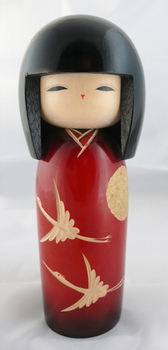Kakeshi Dolls
Kokeshi dolls are Japanese wooden dolls traditionally made in the north of Honshū island. When compared to body size, Kokeshi doll has slightly larger head. It has no arms or legs. Typical floral designs on doll's body are made in red, black or yellow colour. Everything is then covered with layer of wax. Each doll is signed by the artist who made the doll.
 Kokeshi doll
Kokeshi doll
First Kokeshi dolls were made in the middle of Edo period (1600–1868). The place most famous for its Kokeshi dolls is Shinchi Shuraku, near Togatta Onsen, Zaō, Miyagi Prefecture. Traditional Kokeshi (dentō-kokeshi) dolls have shapes and patterns typical for certain town or region. According to experts there are eleven types of traditional Kokeshi dolls - Tsuchiyu, Togatta, Yajiro, Naruko, Sakunami, Yamagata, Kijiyama, Nanbu, Tsugaru, Zao-takayu and Hijioro. The most popular type is the Naruku. Naruku type dolls are made in Miyagi, Akita, Iwate, and Yamagata prefectures. Kokeshi dolls are the big tourist attraction in Naruko Hot Spring resort. The main street of this town includes numerous artists who offer their beautiful Kokeshi dolls in shops.
There are also "creative" kokeshi (shingata-kokeshi) artists whose dolls have their own individual designs, colours and shapes. Such Kokeshi dolls became popular after World War 2. They are made all over Japan.
Different types of wood are used to make Kokeshi dolls. Artists usually use cherry, dogwood and Japanese maple (Itaya-kaede). Before being used wood has to stay outdoors and mature from 1 to 5 years. Old Kokeshi dolls have the status of an antique. They are sold for US$ 1,000 or more. Since 1954 the Prime Minister of Japan gives a special award to the artist who made best creative Kokeshi doll.